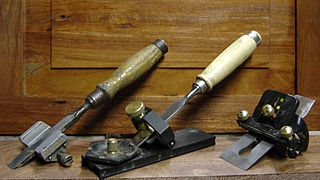This article needs additional citations for verification .(December 2009) (Learn how and when to remove this template message) |
Edge jointing or just jointing is the process of making the edge of a wooden board straight and true in preparation for subsequent operations, often ultimately leading to joining two or more components together. Traditionally, jointing was performed using a jointer plane. Modern techniques include the use of a jointer machine, a hand held router and straight edge, or a table-mounted router.

Wood is a porous and fibrous structural tissue found in the stems and roots of trees and other woody plants. It is an organic material, a natural composite of cellulose fibers that are strong in tension and embedded in a matrix of lignin that resists compression. Wood is sometimes defined as only the secondary xylem in the stems of trees, or it is defined more broadly to include the same type of tissue elsewhere such as in the roots of trees or shrubs. In a living tree it performs a support function, enabling woody plants to grow large or to stand up by themselves. It also conveys water and nutrients between the leaves, other growing tissues, and the roots. Wood may also refer to other plant materials with comparable properties, and to material engineered from wood, or wood chips or fiber.

The jointer plane is a type of hand plane used primarily to straighten the edges of boards in the operation known as jointing. A jointer plane may also be used to flatten the face of a board. Its long length is designed to 'ride over' the undulations of an uneven surface, skimming off the peaks, gradually creating a flat surface. In thicknessing or preparing rough stock, the jointer plane is usually preceded by the fore plane or jack plane and followed by the smoothing plane.
Although the process derives its name from the primary task of straightening an edge prior to joining, the term jointing is used whenever this process is performed, regardless of the application.
Normally, the desired outcome of jointing is an edge which is straight along its length and perpendicular to the face of the board. However, there is a technique often used when gluing up panels, referred to as a sprung joint. [1] In this technique, the desired outcome is an edge which is slightly concave along its length. When two such edges are brought together and clamped, the sprung edges create greater tension at the ends of the join, which assists in creating a seamless joint.

Frame and panel construction, also called rail and stile, is a woodworking technique often used in the making of doors, wainscoting, and other decorative features for cabinets, furniture, and homes. The basic idea is to capture a 'floating' panel within a sturdy frame, as opposed to techniques used in making a slab solid wood cabinet door or drawer front, the door is constructed of several solid wood pieces running in a vertical or horizontal direction with exposed endgrains. Usually, the panel is not glued to the frame but is left to 'float' within it so that seasonal movement of the wood comprising the panel does not distort the frame.
When using a hand plane to perform this operation, two boards are often clamped face to face in the vice and both jointed at once. This creates two edges that are the mirror image of one another. In this way, even if the edges are not perfectly perpendicular to their respective faces, when the two board edges are brought together, the result is a flat panel because the error in each edge cancels the other out.

A vise or vice is a mechanical apparatus used to secure an object to allow work to be performed on it. Vises have two parallel jaws, one fixed and the other movable, threaded in and out by a screw and lever.














